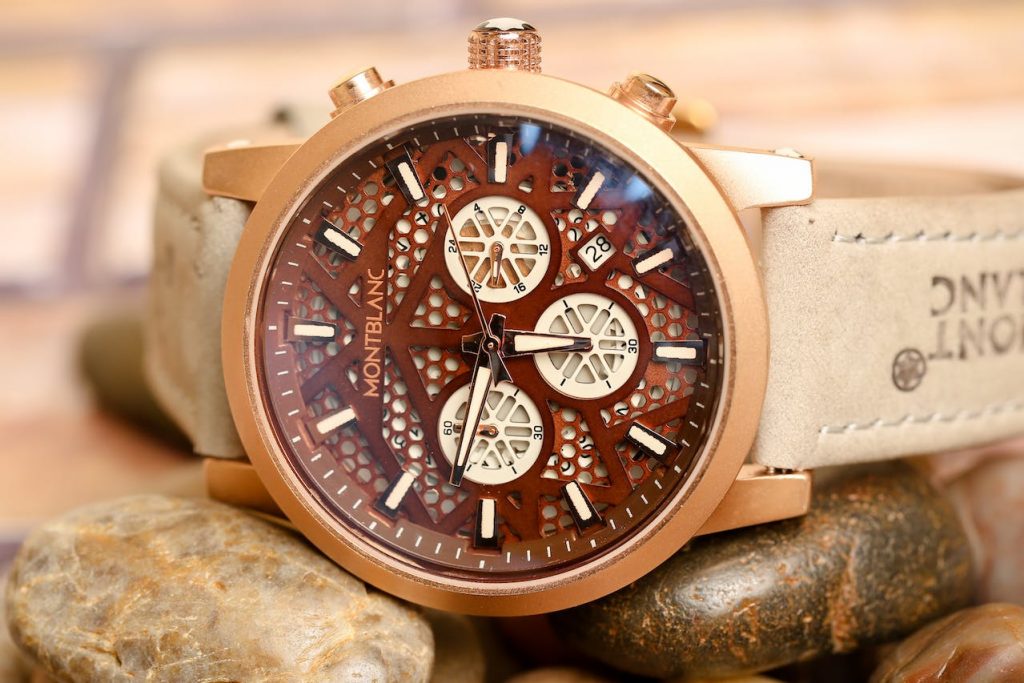Navigating the intricate functions of a chronograph watch may seem daunting for even the most fashion-savvy men. However, understanding this sophisticated timepiece can significantly elevate your style and provide a useful tool for various activities.
This comprehensive guide will demystify the elegant world of chronograph watches, revealing how to operate them effectively. So, whether you’re timing laps on the racetrack, measuring cooking intervals, or simply wanting to make a bold fashion statement, this manual is your ultimate companion in mastering a chronograph watch.
What Is a Chronograph Watch?
A chronograph watch, in its simplest definition, is a timepiece that includes a stopwatch function. This feature sets it apart from regular watches and makes it a multifaceted tool loved by men who appreciate the fine details in fashion.
The watch has three key components: the main clock face, the ‘second’ hand, and the sub-dials. While the main clock and the second-hand function like any regular watch, the chronograph function resides in the sub-dials. Activated by buttons on the side of the watch, these sub-dials can measure time intervals ranging from seconds to hours.
But there’s more to a chronograph watch than meets the eye. It’s not just a stylish accessory; it’s a practical tool that can be used in various scenarios. Imagine timing a perfect steak on the grill, ensuring it’s perfectly cooked. Or calculating your speed based on travel time, whether driving on a highway or running on a track. The chronograph function of this watch allows you to precisely measure these intervals and make the most of your time.
Despite its complex appearance, a chronograph watch isn’t just for show. Its robust functionality and sophisticated appeal make it a favorite among fashion-forward men who value style and practicality. With a chronograph watch on your wrist, you can stay on top of your schedule while elevating your fashion game.
Parts of a Chronograph Watch
Before using a chronograph watch, it’s crucial to familiarize yourself with its various parts. Take a closer look at the key components of this stylish and functional accessory.
Different components of a chronograph watch
The principal components of a chronograph watch, a timepiece renowned for its precision and functionality, include the dial, the hands, the sub-dials, and the pushers. The dial, an elegant canvas, showcases the hours, minutes, and sometimes even the date, offering a comprehensive display of timekeeping.
Next, you will find the hands meticulously crafted and positioned precisely, pointing gracefully to the hours, minutes, and seconds, ensuring accurate timekeeping at all moments. Moving further, most chronograph watches boast three sub-dials, each serving a unique purpose.
The first sub-dial, an embodiment of seamless precision, measures the fleeting seconds, capturing every moment with unparalleled accuracy. The second sub-dial, featuring a meticulous scale, measures minutes, allowing you to accurately track elapsed time. Lastly, the third sub-dial, designed for ultimate functionality, measures hours, providing a comprehensive time perspective.
These sub-dials, harmoniously integrated within the watch’s design, capture the very essence of the chronograph function, elevating its allure and functionality. Finally, the pushers, thoughtfully positioned on the watch’s right side, serve as the control conduits for the chronograph function. The top pusher, when pressed, initiates and halts the chronograph, allowing you to capture the precise moments that matter.
On the other hand, the bottom pusher, when activated, resets the chronograph, preparing it for new adventures and experiences. Understanding and appreciating these meticulously crafted components is the first step in mastering the use of your chronograph watch, unlocking its true potential, and amplifying your style to the next level of sophistication and elegance.
How to Use a Chronograph Watch
Operating a chronograph watch can seem complicated, but once you grasp its functions, it’s as simple as pressing a couple of buttons. This article will walk you through each step to ensure you can utilize your timepiece to its fullest potential.
Step-by-step guide on how to start and stop the stopwatch
To start the stopwatch function on your chronograph watch, gently press the top pusher on your watch’s side. As you press it, you will feel the satisfying click, and the second hand will come to life, smoothly gliding along the dial. With each graceful sweep, the minute sub-dial eagerly follows, advancing one marker for every full second-hand rotation. As time progresses, the hour sub-dial showcases its subtle dance, moving forward with each complete revolution of the minute sub-dial.
This meticulously crafted mechanism allows you to measure time intervals with remarkable precision, empowering you to track and record every moment that matters. Press the top pusher again when you’re ready to pause the stopwatch. The chronograph hands gracefully come to a stop, freezing the elapsed time in its tracks. Take a moment to read and appreciate the journey captured by the precise alignment of these intricate timekeeping components.
Beyond its functional prowess, the chronograph function elevates your timepiece from a mere accessory to a versatile tool, capable of effortlessly complementing any ensemble in a man’s wardrobe. With its user-friendly design and attention to detail, this chronograph watch captures the essence of style and substance, making it essential for the modern gentleman.
The process of resetting the chronograph to zero
To reset the chronograph’s initial position and ensure accurate timing, you will utilize the bottom pusher on your watch’s side. First, make sure the stopwatch stops by pressing the top pusher, allowing you to precisely capture the desired timing.
Once the stopwatch has come to a complete halt, gently press the bottom pusher, initiating a seamless transition. As a result, the second hand, minute sub-dial, and hour sub-dial gracefully return to their original positions, promptly resetting the chronograph back to zero.
This convenient feature is particularly valuable when timing consecutive events, as it allows you to reset and start the stopwatch afresh without any inconvenience effortlessly. With a firm grasp of this straightforward process, you can effectively harness the power of your chronograph watch. It serves as a stylish accessory and becomes a functional tool that adds a touch of sophistication to your overall style, embodying the perfect balance of form and function.
How to Measure Time Intervals Using The Chronograph
The chronograph’s exceptional ability to accurately measure time intervals sets it apart, making it an indispensable tool for men who value style and functionality. When using a chronograph watch to measure time intervals, simply press the top pusher to initiate the stopwatch, taking note of the precise starting time.
Allow the chronograph to run for the desired duration, capturing every moment precisely. Once the interval has elapsed, press the top pusher again to stop the stopwatch function. The sub-dials on the watch now display the exact duration of the timed interval, down to the finest detail.
This remarkable feature proves invaluable in various scenarios, whether tracking the time it takes to complete a task, monitoring workout sessions to optimize performance, or even ensuring the perfect steeping time for your favorite tea.
Remember, mastering this functionality comes with practice. As you become more comfortable with starting, stopping, and resetting your chronograph, you’ll unlock the full potential of this stylish and sophisticated accessory, adding a touch of elegance to your everyday endeavors.
Practical examples and scenarios
One of the most appealing aspects of owning a chronograph watch is its versatility. Imagine you’re at a thrilling racing event, surrounded by the roaring engines and the excitement in the air. As you watch the car’s speed pass, you want to measure the precise time it takes for a car to complete a lap.
With your trusty chronograph watch, it becomes effortless. As the car crosses the start line, you simply press the top pusher, and as it crosses the finish line, you stop it. The sub-dials elegantly display the lap time, allowing you to appreciate the precision and accuracy of your timekeeping companion.
Now, try switching gears and imagining you’re in the cozy comfort of your kitchen, preparing your favorite steak recipe. As you stand there, sizzling pan in hand, you wonder how long to sear the steak on each side to achieve that perfect, mouthwatering sear. Fear not, for your chronograph watch comes to the rescue once again. Start the stopwatch as the steak hits the pan, and as you expertly flip it at the right moment, stop the stopwatch. The recorded time becomes your secret weapon for achieving that beautifully cooked steak just how you like it.
By incorporating your chronograph watch into everyday scenarios like these, you enhance your style and become more adept at utilizing this fashionable accessory confidently and easily. The more you explore the possibilities, the more you’ll discover the endless potential of your versatile timepiece.
How to Use a Tachymeter
A tachymeter is a scale commonly found on the bezel of a chronograph watch and is used to compute speed based on travel time or measure distance based on speed. This feature perfectly harmonizes with the chronograph, offering an additional layer of functionality that can greatly enhance the practicality and style of your timepiece.
To measure speed using a tachymeter, start the chronograph as you pass a marker of a known distance, such as a mile or kilometer marker. As you pass the next marker, stop the chronograph. The number on the tachymeter scale that lines up with the chronograph’s second hand indicates your speed. It’s like having a personal speedometer on your wrist!
In addition to measuring speed, you can also use the tachymeter to measure distance. All you need to do is maintain a constant speed and start the chronograph. As the second hand lines up with your speed on the tachymeter scale, you’ve traveled one unit of distance. It’s a clever way to track your progress during a run, hike, or any activity where distance matters.
Mastering a tachymeter adds a touch of sophistication and practicality to your chronograph watch. Whether you’re a racing enthusiast, a frequent traveler, or simply someone who appreciates the finer details, the tachymeter is a feature that brings both form and function to your wrist.
Care and Maintenance Tips
Proper care and maintenance are essential for preserving the functionality and appearance of your chronograph watch. This section will provide practical tips to ensure your timepiece remains in top-notch condition, enhancing its longevity and preserving its sophisticated appeal.
Tips on cleaning, servicing, and protecting the timepiece
Regular and proper cleaning is essential to keep your chronograph watch looking its best and ensure its longevity. Begin by gently wiping the watch with a soft cloth to remove any surface dirt or dust. Pay attention to the crevices and hard-to-reach areas.
You can use a mild soap and warm water solution for a more thorough cleaning. However, checking if your watch is water-resistant before doing so is crucial. Never submerge a non-water-resistant watch in water to prevent any potential damage. Instead, dip a soft cloth in the soapy water and carefully clean the watch’s case, bracelet, and clasp. Be cautious not to wet the watch’s dial or other sensitive parts.
After cleaning, rinse the watch with clean water to remove any soap residue. Drying the watch thoroughly with a soft towel is important to prevent water spots or moisture build-up.
While cleaning, it is advisable to avoid using harsh chemicals or abrasive materials as they can damage the watch’s finish or scratch the crystal. Stick to gentle cleaning methods to maintain its pristine appearance.
In addition to regular cleaning, having your chronograph watch serviced by a professional every 3-5 years is recommended. This ensures that the internal mechanisms are properly maintained and functioning optimally.
To protect your watch from potential damage, avoid exposing it to extreme temperatures or wearing it during vigorous physical activities. Accidental knocks or drops can cause significant harm to the watch’s delicate components.
What Not to Do With a Chronograph
Despite its robust functionality and stylish appeal, a chronograph watch must be handled with utmost care to avoid any potential damage to its intricate mechanisms. It is crucial to remember a few key precautions to ensure the longevity of your timepiece:
- Firstly, when using a chronograph watch, avoiding pressing the pushers underwater is essential. While the watch may be water-resistant, engaging the buttons underwater can compromise its protection against water intrusion.
- Additionally, it is advised to refrain from changing the date between 9 PM and 3 AM. During this time frame, the watch’s automatic date-change mechanism is engaged, and adjusting it manually can potentially harm the delicate internal components.
- Furthermore, avoiding exposing your chronograph watch to magnetic fields is important. Magnetic fields can interfere with the precise timekeeping of the watch, affecting its accuracy.
- Another important consideration is to never wind the watch while wearing it. Doing so can exert unnecessary pressure on the stem, potentially leading to complications or damage.
- Lastly, to minimize wear and tear on your watch, it is recommended to alternate between different timepieces rather than wearing the same watch every day. This practice allows each watch some downtime, reducing the overall strain on the mechanisms.
By following these meticulous precautions, you can ensure that your chronograph watch retains its stylish appearance and functions flawlessly for many years.
Conclusion
Mastering the functions of a chronograph watch can enhance your appreciation for this stylish accessory, transforming it from a mere fashion statement to a practical tool that can be used in various scenarios. Its ability to measure time intervals, calculate speed, and even distance with the help of a tachymeter makes it a versatile tool for the modern man.
By understanding and respecting its intricate mechanisms and adhering to recommended care and maintenance practices, you can ensure the longevity of your chronograph watch. So, embrace the sophistication offered by this multifaceted timepiece and let it reflect your style and appreciation for finer details. Remember, a chronograph watch is not just a watch; it’s an adventure on your wrist, and this guide is your roadmap.
FAQs
What is the purpose of a chronograph watch?
A chronograph watch serves as a stopwatch and displays the time, enabling precise measurement of time intervals. It’s useful for timing events and calculating speed and adds a stylish touch to men’s fashion.
What is the use of 3 dials on a chronograph watch?
The three dials on a chronograph watch measure seconds, minutes, and hours precisely, providing the stopwatch functionality of the timepiece.
What are the benefits of a chronograph?
A chronograph offers precise time measurement, stopwatch function, stylish appeal, and functionality like calculating speed and distance, making it a versatile tool for fashion-conscious men.
Does the chronograph drain batteries?
The chronograph function can consume more power, potentially leading to a quicker battery drain. However, the effect is typically minimal with modern battery technology.





